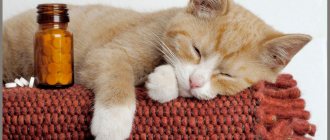Catnip affects the behavior of cats, causing agitation and some degree of aggression. Moreover, the reaction is typical for the entire cat family, that is, for wild species.
The thing is that the herb contains a special compound - nepetalactone, which, when inhaled, affects the brain centers. Interestingly, excitation of the nervous system in response to the entry of the compound into the body occurs only in sexually mature individuals.
The effect of the plant lasts about 15 minutes, gradually weakening, while the cat’s behavior is similar to the period of sexual heat, which is why the grass is called an artificial pheromone.
Description of catnip
Catnip is a perennial herb. It has a straight stem with down, 50 to 100 cm long. The heart-shaped leaves have edges with pronounced serrations. The flowers are light purple or lilac. The smell is vaguely reminiscent of citrus fruits, namely a lemon aroma. Externally, the herb looks like ordinary mint or lemon balm.
The flowering period, as a rule, begins in early summer, and by the end of August the fruits appear - small brown nuts. The plant contains many essential oils.
Description and properties of the plant
A responsible owner approaches any decision regarding his pet carefully. In this case, we should start by answering the question: catnip - what is this miraculous plant?
So, the so-called catnip is a perennial plant of the Lamiaceae family. Before its cultivation began in Europe, it grew in the countries of North Africa and the Mediterranean. This plant is also known as mint catnip and catnip. For those interested in scientific names, the Latin name for catnip is Népeta catária. The plant has diverse properties:
- tonic
- antipyretic
- anti-inflammatory
- painkillers
- sweatshops
- antitussives
- anthelmintic
- choleretic
It's a pity that there are no mint trees...
Next, you should understand how catnip acts on cats in most cases.
How does catnip work on cats?
As we have already said, the stimulating effect of catnip is due to the active substance of the herb - nepetalactone. When animals inhale mint essential oils, this compound contained in them interacts with specific transporter proteins. Subsequently, because of this, the centers of the brain are activated - the amygdala and hypothalamus, which are regulators of the emotional behavior of cats. Stimulation of the centers leads to a change in the pet’s behavior such as sexual hunting. That is, catnip essential oils act on the same principle as pheromones. At the same time, the pet exhibits motor activity, varying degrees of aggression, meows loudly, looks excited and restless. The behavioral reaction of cats to valerian is formed in a similar way.
However, not every cat is susceptible to catnip. The appearance of a response to a plant depends on genetic characteristics. Approximately 30% to 50% of pets (according to various sources) lack the gene locus that is responsible for the perception of aroma, that is, nepetalactone does not interact with the carrier protein, and, therefore, there is no reaction from the central nervous system.
Veterinarian advice
Since pheromones, sprayed at the right time and in the right place, significantly improve the cat’s emotional status and are able to correct the animal’s unacceptable behavior, veterinarians advise trying the effects of catnip to resolve problematic situations. One should not expect unequivocally positive results from the influence of catnip, since its effect is individual in nature. And, of course, for visits to veterinarians to minimize the stress of the animal, veterinarians can also recommend this remedy!
Flehmen is the name given to a cat's grimace when it perceives pheromones. Characterized by an open mouth, raised upper lip and tongue mobility
Uses of catnip
The main application is to correct the behavioral characteristics of cats. If the cat is phlegmatic, then the grass will allow him to show playfulness and improve overall physical and emotional activity.
The plant is often used to transport animals when moving or traveling. This is needed to stabilize the emotional background and reduce stress.
Also, with the help of the smell of plants, they accustom a cat to a scratching post or tray:
- To train him to use the litter tray, place a few catnip leaves next to the litter box. The smell helps to attract your pet's attention. However, it is worth changing the plant several times a day, because essential oils disappear quickly.
- If you need to accustom your cat to a scratching post, you need to rub its surface with catnip. Your pet will also be attracted to the scent.
It is important to note that experts do not recommend using catnip or valerian for litter box training, etc., as there is a risk that the cat will not use it in the future. Veterinarians draw the attention of owners to the fact that a cat can be raised without additional funds, the main thing is to be patient.
Sometimes the dried plant is placed in a bag and thus made into a toy with which the cat is more willing to play.
If your pet refuses to eat, it is recommended to add a small amount of dry crushed grass leaves to the food bowl.
Veterinarians say that catnip has a calming effect on the digestive tract - it reduces the motility of the stomach and intestines. Therefore, it is recommended to use it in cases of simple food poisoning or exacerbations of chronic diseases. However, do not abuse it under any circumstances.
According to some reports, catnip helps with helminthiasis. However, this has not been proven.
The grass is not addictive.
The listed methods of using mint only affect mature cats, since kittens under the age of six months do not react to the active substances of catnip.
When using a purchased plant-based product, it is recommended to carefully read the attached instructions for use. High doses are harmful to your pet.
Contraindications
In addition to the benefits, the plant also causes harm:
- Veterinarians do not recommend the use of catnip if the pet is showing severe aggression. High activity of the central nervous system leads to neurological disorders as a result of depletion of the neurotransmitter system.
- It is forbidden to give grass to cats during pregnancy. Stimulation of the nervous system has a negative effect on the condition of the future offspring, and can also provoke premature birth or miscarriage.
It is important to consider that regular long-term use of the plant causes dangerous conditions in cats.
Growing and storing catnip
Burda can be grown at home. It is best in a flowerbed or in a vegetable garden, but it is also possible indoors, for this you need a large pot.
After preliminary germination of the seeds in the pot, the plant is planted in the soil. For normal growth, a sufficient amount of sunlight is necessary, so do not choose shady areas.
The plant reaches 50-100 cm in height. In mid to late summer, leaves and flowers are collected and used for medicinal purposes, as a seasoning, and to correct pet behavior.
The collected herbs are dried in a dry, dark place. The shelf life is one year. Cultivation does not require frequent care or special conditions.
How to grow catnip in a pot - step by step instructions
In nature, catnip can be found in forests, bushes, meadows, fields, vegetable gardens, along river banks and near roads. To be able to pamper your pet at home, you can grow the plant indoors in a pot. Please note that catnip loves warmth, moisture and light. A lack of these components can negatively affect the performance of the plant.
Catnip can be grown from seeds, which are sold at any pet store. But it’s better to take a cutting or a rooted shoot, which can be found right on the street. The cutting should be placed in a glass of water, where it should remain until roots appear. When choosing a pot, you need to give preference to a medium-sized container.
- Pour drainage into the pot.
- Fill the container halfway with soil, which should be pre-moistened.
- Plant seeds or seedlings in the ground.
- Cover the pot with film, creating greenhouse conditions.
- Place the container in a lighted place.
After two weeks, sprouts should appear. When the first leaves form, the plant should be fed. It is necessary to select the strongest shoots and clear space for their growth. The stems need to be secured with wire. About 2.5 months after planting, with proper care, catnip should bloom.
Attention!
The pot with the plant must be placed in a place inaccessible to the cat. Otherwise, the animal will damage the sprouts and the catnip will die.
It's safe to say that catnip is a plant covered in legends.
.
Some pet owners welcome it, while others, on the contrary, are against it. So, what is catnip for? Are there any benefits to human health? Why are cats given this grass? What are the features of its application? Is it really good for your pets
or is it a real drug? You can find answers to these questions in this article.
Description of catnip
Catnip is a perennial herbaceous plant belonging to the Lamiaceae family. It is distinguished by its unpretentiousness and endurance. Resistant to low temperature changes. It can reach 40-100 centimeters in height. Alternative names include lemon catnip, cat's drink, field balm, catnip, and fragrant horehound. A distinctive feature of this plant is its effect on the behavior of cats. In the wild, this grass can be found along roads, in forests, in meadows and fields, hillsides and garden plots.
External signs
:
- long stem;
- oblong leaves of gray-green color in the shape of a heart;
- small flowers collected in brushes (from white to purple);
- aroma with notes of lemon.
The main difference between catnip and regular mint is the essential oils that make up the herb.
Catnip essential oil contains nepetalactone, while peppermint contains menthol. This is why plants have different smells. In addition, this herb contains vitamins A, C, a group of B vitamins, as well as trace elements, tannins and terpenes.
Why do people need catnip?
Due to its rich content of beneficial substances, catnip has found use in alternative medicine. It has anti-inflammatory, antiseptic and antibacterial effects.
- Compresses and lotions made from this herb are often used to treat skin diseases and acne. An antiseptic decoction of the leaves fights suppuration on the skin.
- Also, with the help of catnip, diseases of the digestive tract are treated.
- Mint has a beneficial effect on the blood coagulation system, thereby stopping bleeding.
- Another advantage is the reduction of blood pressure in hypertension.
- The use of herbal decoctions and extracts helps fight insomnia.
- Mixing lemon balm or peppermint and catnip is used for inflammatory processes - menthol has an analgesic effect, and essential oils soothe the lesion.
The beautiful color of the flowers and ease of care are a plus when planting in the ground. Therefore, the plant is used in landscape design. In addition, catnip is a perennial plant. This feature allows you not to replant mint every year.
The pronounced lemon smell is used in cooking as a spice. The plant is added to pies, pastries, and cakes.











